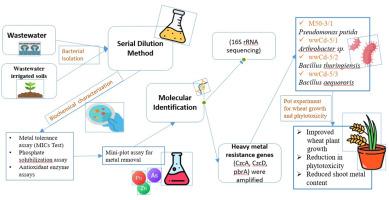Heavy metals removal and reduction of heavy metal phytotoxicity by Arthrobacter, Bacillus, and Pseudomonas strains harboring genes encoding metal resistance
IF 3.8
Q2 BIOTECHNOLOGY & APPLIED MICROBIOLOGY
引用次数: 0
Abstract
An experiment was conducted to assess the potential of bacteria isolated from wastewater-irrigated soils to remediate heavy metals and mitigate heavy metal-induced phytotoxicity in wheat. Four bacterial isolates, i.e., M50-3/1, wwCd-5/1, wwCd-5/2, and wwCd-5/3 were isolated from wastewater-irrigated soils and tested for metal tolerance by MIC assay. Metal removal efficiency was evaluated in a mini-pilot assay involving both wastewater and contaminated soil. The bacterial isolates showed tolerance to all the levels (50–2000 mg L−1) of the heavy metals (Cd, Pb, and Zn). Whereas, for As the MIC values of the isolates M50-3/1, wwCd-5/2, and wwCd-5/3 were 100, 2000, and 500 mg L−1, respectively. All the bacterial isolates significantly solubilized higher amounts of phosphate, produced IAA and antioxidants (APX, CAT, and POX) in the growth medium supplemented with 500 mg L−1 each of As, Cd, Pb, Zn, individually and in combined application as compared to control. In the assay, the lowest amounts of As (45.0 μg L−1), Cd (0.21 μg L−1), Pb (0.77 μg L−1), and Zn (0.3 μg L−1) were detected in the supernatant of treatment T4. The isolates wwCd-5/1, wwCd-5/2, wwCd-5/3, and M50-3/1 were identified as Arthrobacter sp., Bacillus thuringiensis, Bacillus aequororis, and Pseudomonas putida, respectively, through 16S rRNA sequencing. The amplified sequences of heavy metal resistance-encoding genes (CzcA, CzcD, and pbrA) from four isolates revealed significant sequence homology with those found in Bacillus and Pseudomonas strains. The application of metal-tolerant bacteria improved plant growth and reduced shoot metal contents and phytotoxicity under metal stress of 500 mg kg−1.

含有金属抗性基因的节杆菌、芽孢杆菌和假单胞菌对重金属的去除和重金属植物毒性的降低
本试验旨在评估从废水灌溉土壤中分离的细菌对小麦重金属修复和减轻重金属诱导的植物毒性的潜力。从废水灌溉土壤中分离到M50-3/1、wwCd-5/1、wwCd-5/2和wwCd-5/3 4株细菌,并采用MIC法对其金属耐受性进行了测试。在涉及废水和污染土壤的小型中试试验中评估了金属去除效率。该菌株对50 ~ 2000 mg L−1的重金属(Cd、Pb、Zn)均表现出耐受性。菌株M50-3/1、wwCd-5/2和wwCd-5/3的MIC值分别为100、2000和500 mg L−1。与对照相比,在分别添加500 mg L - 1的砷、镉、铅、锌的培养基中,所有分离的细菌都能显著增加磷酸盐的溶解量,产生IAA和抗氧化剂(APX、CAT和POX)。结果显示,T4处理的上清液中砷(45.0 μ L−1)、镉(0.21 μ L−1)、铅(0.77 μ L−1)、锌(0.3 μ L−1)含量最低。经16S rRNA测序,分离物wwCd-5/1、wwCd-5/2、wwCd-5/3和M50-3/1分别为节杆菌、苏云金芽孢杆菌、水芽孢杆菌和恶臭假单胞菌。4株菌株的重金属抗性编码基因(CzcA、CzcD和pbrA)扩增序列与芽孢杆菌和假单胞菌的序列具有显著的同源性。在500 mg kg−1的金属胁迫下,施用耐金属菌促进了植株生长,降低了茎部金属含量和植物毒性。
本文章由计算机程序翻译,如有差异,请以英文原文为准。
求助全文
约1分钟内获得全文
求助全文
来源期刊

Biocatalysis and agricultural biotechnology
Agricultural and Biological Sciences-Agronomy and Crop Science
CiteScore
7.70
自引率
2.50%
发文量
308
审稿时长
48 days
期刊介绍:
Biocatalysis and Agricultural Biotechnology is the official journal of the International Society of Biocatalysis and Agricultural Biotechnology (ISBAB). The journal publishes high quality articles especially in the science and technology of biocatalysis, bioprocesses, agricultural biotechnology, biomedical biotechnology, and, if appropriate, from other related areas of biotechnology. The journal will publish peer-reviewed basic and applied research papers, authoritative reviews, and feature articles. The scope of the journal encompasses the research, industrial, and commercial aspects of biotechnology, including the areas of: biocatalysis; bioprocesses; food and agriculture; genetic engineering; molecular biology; healthcare and pharmaceuticals; biofuels; genomics; nanotechnology; environment and biodiversity; and bioremediation.
 求助内容:
求助内容: 应助结果提醒方式:
应助结果提醒方式:


